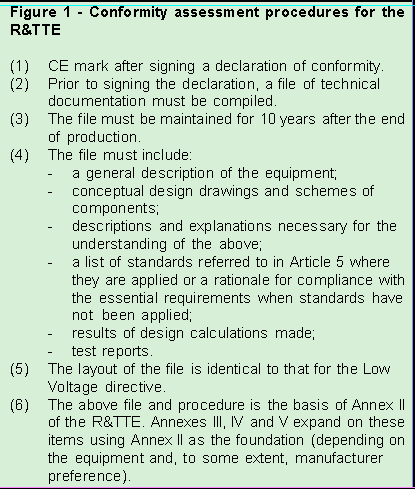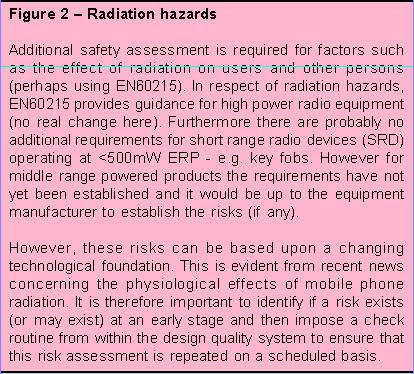
How safety and EMC integrate with the R&TTESimon Barrowcliff, TRL Compliance Services Ltd |
For the purposes of CE marking, the R&TTE directive covers the majority of radio and telecommunications equipment. This includes equipment for use by consumers (such as telephones or baby alarms) and commercial equipment (such as telecommunications switching equipment or broadcast radio apparatus). The directive has no restriction on power supply type or input voltage level and hence applies to battery powered and mains powered equipment.
| R&TTE Forum Proceedings |
|---|
|
An R&TTE Forum at Newbury, chaired by Vic Clements, Radio Frequency Investigation Ltd, included presentations by Martin Fenton, Radiocommunications Agency; Dr Michael Sharpe, ETSI; Ken White, BSI; Simon Barrowcliff, TRL EMC Ltd; Ben Wrigley, KTL Ltd and Paul Lewis, BABT Product Service Ltd.
130 Pages of infomation on R&TTE. Cost £35. |
Generally the equipment within the scope of the R&TTE is electrical equipment. Consequently, it may already be subject to requirements of existing directives for EMC and safety (usually the Low Voltage Directive, but it may include directives for medical devices or equipment for use in explosive atmospheres). However, the introduction of the R&TTE has important implications for the EMC and Low Voltage Directives since it directly calls out both sets of regulations from within its own requirements.
The procedures for establishing EMC and safety allow a choice of routes. This is outlined in R&TTE Article 10.2. Option 1 (referring back to Article 3(1)(a)) makes use of the existing conformity assessment procedures that are externally laid out in the EMC directive 89/336/EEC and the Low Voltage directive 73/23/EEC. Option 2 allows the use of the procedures for EMC and safety laid out within the R&TTE directive itself. Effectively this choice is limited to the conformity assessment procedures since with either option the technical requirements are generally based on EN standards.

Option 1 (calling out the requirements of the EMC and Low Voltage directives from within the R&TTE) offers the potential for using the existing documentation that manufacturers may have established prior to the introduction of the R&TTE. For EMC this allows the use of the technical evidence of the EMC directive (typically a report or certificate with test data where standards have been used). For safety, the more involved technical documentation file associated with the Low Voltage directive is required (a mandatory file of design data, component specifications/approvals and test reports). The main restriction on the use of option 1 is that the particular equipment must be within the scope of that directive. If manufacturer's equipment already has an EMC certificate/report and the file associated with the Low Voltage directive then these two elements of the R&TTE are covered with no further work required.
Option 2 uses the in-built R&TTE procedure for EMC and safety. It also relies upon the use of standards listed in the Official Journal under the R&TTE if Annex II is to be followed. EMC and Low Voltage directive listed standards are now listed by default under the R&TTE and may be used within R&TTE conformity assessment procedures. The main difference under this option is highlighted in Article 10 and applies for radio equipment that is subject to formal technical file review by a notified body under Annexes III and IV. This review would include the safety and EMC evidence and may therefore introduce additional paperwork to that necessary under option 1.
With either option, the routes for meeting EMC requirements are fairly straightforward. The procedures are essentially identical to those used for traditional EMC compliance. Assessment is based largely on listed standards and there are a plethora of ETS and EN specifications available (more have recently been listed). Self-declaration (Annex II) is therefore possible without generating the too much extra paperwork. Typically compliance would be based upon basic EMC standards such as the EN61000 series (e.g. EN61000-4-2, 3, 4, 5, 6, 8 and 11). For most equipment, the procedures familiar for normal EMC directive compliance will apply. These procedures could include the technical construction file route and competent body involvement.
Safety using the Low Voltage directive is a little more complex with two key issues. Firstly, the R&TTE modifies the scope of the Low Voltage directive such that the upper and lower voltage limits have been removed. Of particular interest are the lower voltage limits associated with the Low Voltage directive (50Vac and 75Vdc). Previously, these limits would have excluded a variety of telecommunications system powered equipment and battery powered radio equipment from the scope of a Low Voltage directive technical assessment. This is particularly important for equipment powered by battery and equipment powered from low voltage telecommunications sources that may therefore be subject to a specific and formal CE safety evaluation for the first time. However, it is worth noting that since the option 1 conformity assessment procedure may only be followed if the equipment is within the with original Low Voltage directive voltage limits (i.e. >50Vac and >75Vdc) then for these latter categories of equipment only option 2 may be available. This means that the technical requirements are based on Low Voltage directive standards but conformity assessment is taken from within the R&TTE only (in practice, not significantly different from the Low Voltage directive requirements).
The second safety issue is that the R&TTE describes this as a health and safety assessment and does not limit it to the Low Voltage directive objectives nor to the standard applied. There is an explicit obligation to consider the broader aspects of safety of the equipment above the objectives of the Low Voltage directive. This may have particular implications for radio transmitters (see figure 2) but also highlights a potential problem with the standards approach to compliance, in that they may not cover all of the hazards associated with a given piece of equipment (particularly with leading edge or developing technologies). The choice of words within the R&TTE clarifies the view of these broader safety issues even though the requirements and objectives of the Low Voltage directive do in fact encompass them quite adequately (albeit less obviously).

When assessing for safety there are a large number of standards that can be applied (over 500 are listed in the Official Journal). However most radio or telecommunications equipment will fall within the scope of one of four prominent standards (see figure 3). The assessment process is more straightforward if compliance can be established using a single standard. However, where more than one standard needs to be applied (or if there is no standard obviously available) then the Low Voltage directive advises that the assessment be referred to a Low Voltage directive notified body for a formal evaluation. This latter route may also be applied to the safety assessment of equipment that is not mains powered. For example, in the case of a battery powered equipment, the EN standard may contain many clauses that are not applicable (or appear not to be applicable) and this can cause confusion when determining what testing or assessment to perform.

When approaching compliance with the R&TTE it is critical to establish the sub-routes applicable to EMC and safety. These are at least equally important as the route for ensuring correct functional performance. The responsibility for ensuring that these elements are satisfied now rests largely with the manufacturer or importer. However, help is at hand from many of the test and assessment bodies listed under the R&TTE and they should be able to guide you through the detailed requirements.
Simon Barrowcliff is a director of the safety division of TRL Compliance Services Ltd.
TRL is a notified body under the R&TTE and Low Voltage directives and a competent body under the EMC directive.
Tel: 01695 556666
Fax: 01695 557077
Email:simon@richtec.co.uk
 © Nutwood UK Ltd 2001 |
Eddystone Court - De Lank Lane St Breward - BODMIN - PL30 4NQ Tel: +44 (0)1208 851530 - Fax: +44 (0)1208 850871 nutwooduk@nutwood.eu.com |
|
|
|